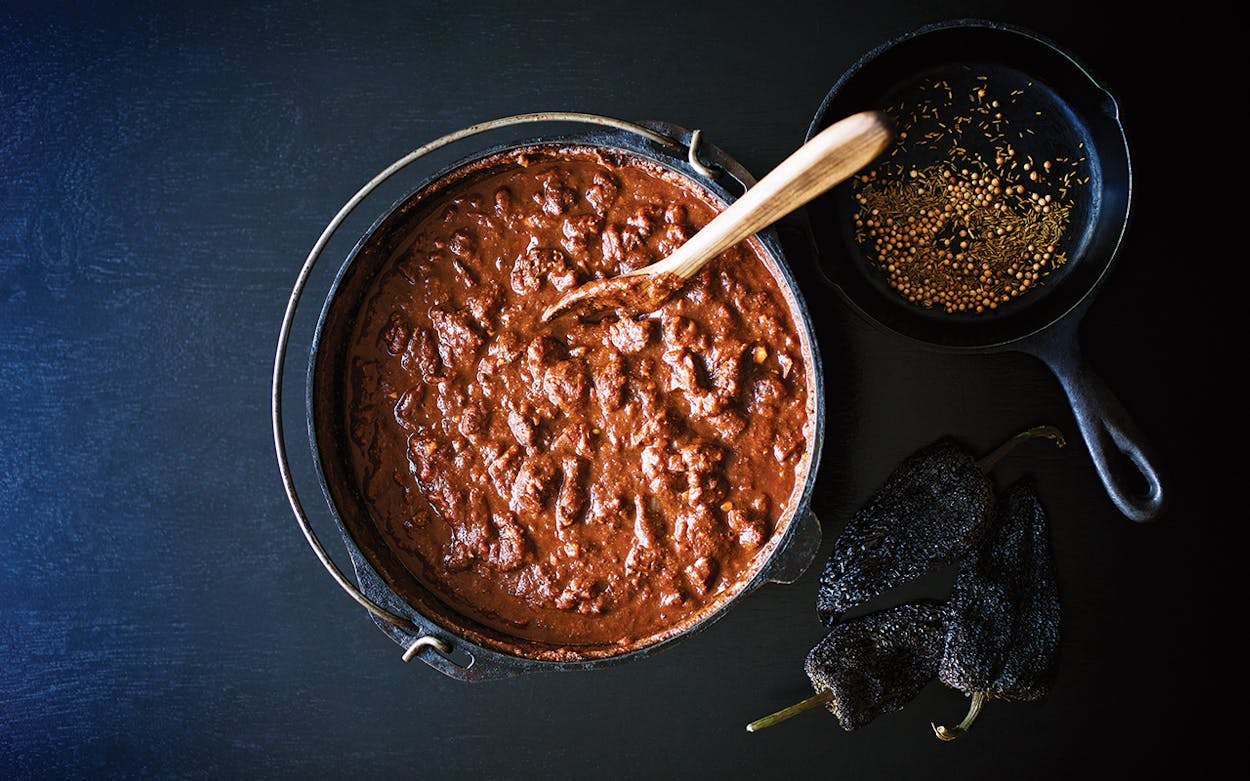Bust out the Dutch ovens: it’s getting “chili” in Texas. The origins of the robust dish Texans fervently claim as their own are, as food writers are wont to say, lost to history. But Frank X. Tolbert, in his 1953 treatise on Texas chili, A Bowl of Red, made a pretty good case for San Antonio as the birthplace of the ruddy, lustrous, peppery pot of meat we’re so fond of. So did the Sixty-fifth Legislature, which anointed it our official dish in 1977, boldly declaring that “Texans continue today the tradition begun in San Antonio 140 years ago of making the best and only authentic concoction of this piquant delicacy.” No doubt chili’s connection to Texas is deep and indisputable, from Gebhardt to Wolf brand, from the late-nineteenth-century “chili queens” of the Alamo City’s downtown plazas to the modern-day maestros of the Terlingua cookoffs.
But don’t look for a united Texan front when it comes to defining “authentic” (except for a near universal, almost hysterical aversion to the inclusion of beans). I lack the fortitude to wade into the murky depths of secret formulas and verboten ingredients and therefore align myself with the author of this recipe, Terry Thompson-Anderson, who reasonably suggests that perhaps “the rivalry and the controversy make for dozens of equally fabulous bowls of chili.”
This article originally appeared in the December 2015 issue of Texas Monthly with the headline “Chili.”

The Only Texas Chili Recipe You’ll Ever Need
Equipment
- 1 twelve- to fourteen-inch skillet
- 1 spice or coffee grinder
Ingredients
- 12 ancho chiles, stems and seeds removed
- 7 pasilla chiles, stems and seeds removed
- 2½ tablespoons cumin seeds, toasted, then ground
- 1 tablespoon whole coriander seeds, toasted, then ground
- 1½ tablespoons dried Mexican oregano
- 2 teaspoons unsweetened cocoa
- 1½ tablespoons sweet Hungarian paprika
- ½ teaspoon cayenne
- 2 teaspoons freshly ground black pepper
- 6 pounds beef chuck roast
- ⅓ cup fresh leaf lard (preferable) or shortening
- 2 large onions, chopped
- 15 garlic cloves, minced
- ⅔ cup tomato paste
- 1 can (15 ounces) tomato sauce
- 3 quarts chicken stock (set aside ⅔ cup for the masa harina)
- ½ cup masa harina whisked into ⅔ cup hot chicken stock
- kosher salt
Directions
- Heat a heavy-bottomed 12- to 14-inch skillet over medium-high heat. When the pan is hot, add a layer of the chiles. Cook, turning often, until a strong chile aroma—one that is not bitter or charred—emanates from the pan. Do not allow the chiles to burn. Spread the chiles on a wire rack to cool and become moderately crisp. Repeat until all the chiles have been toasted.
- Grind the chiles to a fine powder in an electric spice or coffee grinder. Shake the chile powder through a fine strainer to remove any large pieces.
- Combine the ground chiles with the cumin, coriander, oregano, cocoa, paprika, cayenne, and black pepper. Set the mixture aside.
- Trim the chuck roast, removing all fat, gristle, and tendons. Chop the meat by hand into ½-inch dice; set aside.
- Melt the lard in a heavy-bottomed 8-quart (or larger) Dutch oven over medium-high heat. When the fat is hot, add the meat and sear, stirring often.
- Add the onions and garlic. Cook, stirring often, until the onions are wilted and transparent, about 7 minutes.
- Add the tomato paste and stir to blend well. Cook, stirring, until the tomato paste is thick and dark in color, about 5 minutes. Add the tomato sauce and chile-spice mixture. Stir to blend well, then add the chicken stock.
- Bring the mixture to a full boil, then lower heat to a simmer and cover. Cook, stirring occasionally, for about 1½ hours.
- Stir in the masa mixture and salt to taste.
- Cook, uncovered, an additional 30 to 45 minutes on low-medium heat, or until the chili is thickened and the meat is fork-tender. Stir often to prevent sticking. Taste and adjust seasonings as desired. Serve hot and add your favorite toppings (diced onion, avocado, sour cream, shredded cheese, corn chips, et cetera).

















